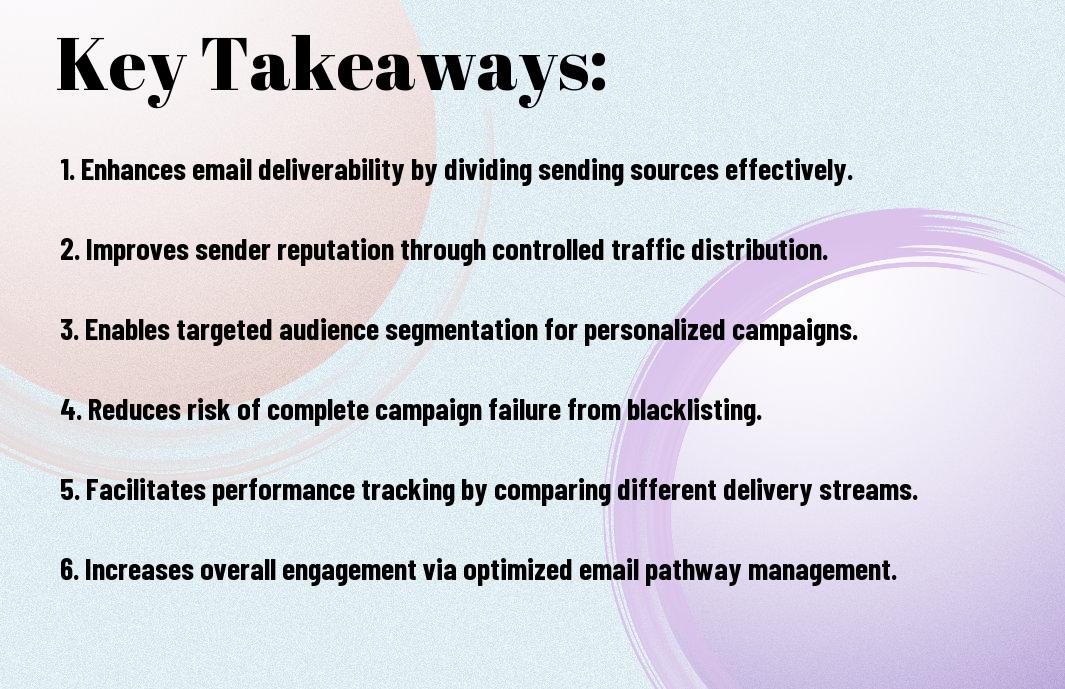Many marketers today are exploring innovative strategies to enhance their email campaigns, and the paradigm of split email delivery is at the forefront. This approach allows you to optimize your email marketing by segmenting your audience and testing different content strategies simultaneously, which can lead to improved engagement and conversion rates. By understanding how to implement and analyze split delivery methods, you can better tailor your messages and reach your target audience effectively. This post will guide you through the transformative impact of this strategy on your email marketing efforts.

Key Takeaways:
- Split email delivery allows marketers to test different variations of emails, optimizing content for higher engagement and conversion rates.
- This approach helps identify specific audience segments and preferences, enabling more personalized and targeted marketing campaigns.
- By analyzing metrics from split deliveries, businesses can make data-driven decisions to improve future email strategies and overall performance.
- It encourages ongoing experimentation, fostering a culture of innovation within email marketing teams and enhancing overall campaign effectiveness.
- Split email delivery can improve deliverability rates by fine-tuning send times and frequency based on recipient behaviors and preferences.
The Shift Towards Split Email Delivery
As email marketing evolves, many businesses are embracing split email delivery as a strategy to enhance audience targeting and engagement. This innovative approach allows brands to segment their email campaigns more effectively, delivering tailored content that resonates with specific groups of recipients and ultimately drives better results.
Defining Split Email Delivery in Today’s Market
Split email delivery refers to sending different versions of an email to distinct segments of your audience to evaluate which performs better. This strategy leverages A/B testing methodologies, enabling marketers to assess various factors such as subject lines, content, and call-to-action buttons for optimized campaign performance.
Key Drivers Prompting the Adoption of Split Email Delivery
Several factors are accelerating the shift toward split email delivery, including the growing demand for personalized marketing, advancements in data analytics, and the need for higher ROI. Businesses are increasingly recognizing that tailored content leads to improved customer experience and engagement, thus prompting this strategic pivot.
The rise in customer expectations for personalized experiences encourages marketers to adopt specialized tactics like split email delivery. As your audience becomes more discerning, the use of data analytics allows you to gather insights on recipient behavior, enabling precision-targeted campaigns. This data-driven approach not only enhances engagement rates but also drives higher conversion rates as you deliver relevant content that addresses individual needs. Moreover, the need for stronger ROI in a competitive landscape inspires brands to implement strategies that yield measurable results through continuous testing and learning.

The Mechanics of Split Email Delivery
The mechanics of split email delivery hinge on the ability to send multiple versions of an email to different segments of your audience simultaneously. This approach allows marketers to experiment with various content, subject lines, and calls to action to determine which combinations resonate best with their audiences. By using sophisticated analytics tools, you can track engagement metrics and conversion rates in real-time, optimizing your approach for maximum impact.
How Split Email Delivery Works: A Technical Breakdown
Split email delivery leverages smart segmentation techniques to divide your subscriber list into smaller groups based on specific criteria like demographics, past behaviors, or engagement levels. Once segmented, you create different email variations and send them out at the same time. Advanced email marketing software can monitor the performance of each version, collecting data on opens, clicks, and conversions to help you make informed decisions about future campaigns.
Analyzing Response Rates: The Impact of Segmentation
Segmenting your audience allows for a more tailored messaging strategy, resulting in higher response rates. By comparing the performance of different email variants across segments, you can uncover trends and insights that reshape your marketing efforts. For instance, an analysis may reveal that younger audiences respond better to dynamic visuals, while older recipients prefer straightforward text. Utilizing these insights ensures that your emails deliver content that resonates with each group, boosting engagement and conversion potential.
Delving deeper into response rates, studies indicate that segmented campaigns can yield up to 760% more revenue than non-segmented ones. By splitting your email delivery, you can directly attribute variations in performance to your messaging choices, giving you an unparalleled advantage in testing and optimization. For example, if you notice that a specific call to action drives more clicks among a certain demographic, you can prioritize that approach in future communications. This level of targeted refinement not only improves engagement but also helps you build stronger relationships with your subscribers, ultimately leading to increased loyalty and sales.
Tactical Advantages: Why Split Email Delivery Matters
The tactical advantages of split email delivery lie in its ability to refine your marketing strategies across various touchpoints. By testing different subject lines, content placements, or calls to action, you can gain insights into what resonates best with your audience. This iterative approach not only boosts open rates and click-through rates but also leads to heightened conversion levels and improved customer satisfaction. Implementing split email delivery gives you the agility to adapt your campaigns based on real-time data, ensuring your messaging aligns more closely with your audience’s preferences.
Enhancing Personalization with Split Testing
Split testing enhances personalization by allowing you to tailor emails based on distinct audience segments. For instance, varying the tone of your message for different demographics can result in a more relevant and engaging experience. By analyzing performance metrics from segmented lists, you fine-tune your approach, ensuring that each recipient feels the email is crafted just for them.
Driving Engagement Through Tailored Content Strategies
Engagement significantly increases when you leverage tailored content strategies through split email delivery. By segmenting your audience and creating content that speaks to specific interests or behavioral patterns, you significantly enhance the likelihood of engagement. For example, if your analytics indicate that younger demographics respond better to vibrant visuals and interactive content, you can craft emails specifically designed for them, while simultaneously offering a different experience tailored to older audiences. This targeted approach heightens interaction rates, fosters loyalty, and drives overall campaign success.
Navigating Challenges: Potential Pitfalls of Split Email Delivery
Understanding the potential pitfalls of split email delivery is important for successfully navigating this innovative approach. While it offers significant benefits, you must also be mindful of challenges such as data privacy concerns, compliance implications, and the complexities of resource allocation between different segments.
Data Privacy Concerns and Compliance Implications
Your email marketing strategies must comply with regulations such as GDPR and CAN-SPAM. Split email delivery can complicate compliance, especially if user data isn’t properly segmented or if variable consent mechanisms aren’t maintained across different segments. This can expose your business to legal risks and reputational damage.
Resource Allocation: Balancing Efforts Across Segments
Properly managing resources for split email delivery can be a balancing act. Allocating your time, budget, and team efforts equally across segments may lead to inefficiencies, while favoring one over another can skew data results and impact overall campaign outcomes.
Efficiently balancing resources requires careful planning and analysis of where your efforts yield the highest returns. For instance, if analytics show that one segment consistently engages better, it may warrant additional investment in creative or technological resources. Conversely, underperforming segments might not deserve the same level of attention. Implementing a system for tracking engagement metrics across all segments helps in refining your strategy, allowing you to pivot and allocate resources where they will drive the most value. By fostering this adaptability, you can keep your marketing efforts responsive and dynamic, ensuring each segment is nurtured effectively according to its unique behavior and preferences.

The Future of Email Marketing: Embracing Change
The evolution of email marketing necessitates a forward-thinking approach that embraces innovative methods like split email delivery. As consumer preferences shift and technology advances, your strategies must stay ahead of the curve. Adaptability to these changes will not only enhance engagement but also build stronger relationships with your audience, ultimately driving better results for your campaigns.
Predictions for Split Email Delivery Evolution
Expect split email delivery to evolve into even more sophisticated formats, leveraging artificial intelligence to tailor communications with pinpoint accuracy. By harnessing machine learning algorithms, your campaigns could analyze user behavior and preferences in real-time, allowing for hyper-personalized content that resonates with each subscriber on an individual level.
Integrating New Technologies for Enhanced Performance
Utilizing advanced technologies will significantly improve the effectiveness of split email delivery. Incorporating tools like predictive analytics can help you anticipate user behavior and further refine your segmentation strategy. Additionally, automation platforms will streamline your processes, enabling you to focus on crafting compelling content while technology handles distribution and performance tracking.
Integrating these new technologies creates a synergy that enhances performance and efficiency. With predictive analytics, you can analyze vast amounts of data to identify trends and preferences among subscribers, allowing for the creation of targeted email campaigns that yield higher open and conversion rates. Moreover, automation tools can manage recipient lists, trigger responses based on user interactions, and even A/B test different versions of your emails seamlessly, providing you with valuable insights to optimize future campaigns. By embracing these advancements, you’re positioning your email marketing strategy to thrive in an ever-changing digital landscape.
Final Words
As a reminder, embracing the paradigm of split email delivery can significantly transform your email marketing approach by enhancing deliverability, engagement, and customization. By strategically separating your transactional and marketing emails, you can ensure that your recipients receive relevant content without compromising the performance of critical communications. To explore best practices further, you might find insights from the Reddit community helpful regarding Is best practice to use a separate email for email marketing?. Adapting your strategy in this way empowers you to create a more effective marketing campaign.
FAQ
Q: What is split email delivery?
A: Split email delivery refers to a strategy in email marketing where a single email campaign is divided into multiple versions, allowing marketers to send different variations to different segments of their audience. Each version can be tailored based on factors such as demographics, preferences, or engagement levels. This technique enables marketers to test various elements—like subject lines, content, and call-to-action—to determine which version resonates best with the targeted audience.
Q: How does split email delivery enhance engagement rates?
A: By personalizing content to align with the preferences and behaviors of specific audience segments, split email delivery can significantly boost engagement rates. When recipients receive messages that are relevant and appealing to them, they are more likely to open emails, click on links, and engage with the content. This personalization fosters a sense of connection between the brand and the subscriber, ultimately leading to higher conversion rates.
Q: What metrics can be improved through split email delivery?
A: Split email delivery can improve several key performance metrics in email marketing campaigns, including open rates, click-through rates (CTR), conversion rates, and overall return on investment (ROI). By analyzing the performance of different email versions, marketers can gain valuable insights into audience behavior and preferences, allowing them to refine future campaigns for even better results.
Q: How does split email delivery support A/B testing?
A: Split email delivery is inherently linked to A/B testing, as it allows marketers to simultaneously test two or more versions of an email to identify which performs better. This systematic approach to experimentation helps marketers understand what elements drive engagement, leading to data-driven decisions in future campaigns. By optimizing email content based on actual performance data, marketers can continuously improve their email strategies.
Q: What are the challenges associated with implementing split email delivery?
A: While split email delivery offers numerous benefits, it also presents some challenges. Marketers must ensure they have a robust email segmentation strategy in place to effectively target their audience. Additionally, managing multiple email versions requires extra resources for tracking performance and analyzing data. There is also a risk of overwhelming recipients if too many variations are sent, so finding the right balance is imperative for success.

